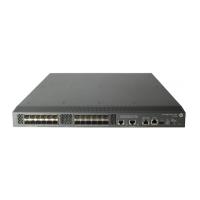309
When configured on an interface, the ip binding vpn-instance command clears the IP address of the
interface. You must re-configure the IP address of the interface after configuring the command.
The Layer 3 Ethernet interface refers to the Ethernet port that can perform IP routing and inter-VLAN
routing. You can set an Ethernet port as a Layer 3 Ethernet interface by using the port link-mode route
command (see the Layer 2—LAN Switching Configuration Guide).
Syntax
ip binding vpn-instance vpn-instance-name
undo ip binding vpn-instance vpn-instance-name
View
VLAN interface view, Tunnel interface view, Management Ethernet interface view, Layer 3 Ethernet
interface
Default level
2: System level
Parameters
vpn-instance-name: Specifies the name of the VPN instance to be associated, which is a case-insensitive
string of 1 to 31 characters.
Examples
# Associate interface VLAN-interface 1 with the VPN instance vpn1.
<Sysname> system-view
[Sysname] interface vlan-interface 1
[Sysname-Vlan-interface1] ip binding vpn-instance vpn1
ip vpn-instance
Description
Use the ip vpn-instance command to create a VPN instance and enter VPN instance view.
Use the undo ip vpn-instance command to delete a VPN instance.
A VPN instance takes effect only after you configure an RD for it.
Related commands: route-distinguisher.
Syntax
ip vpn-instance vpn-instance-name
undo ip vpn-instance vpn-instance-name
View
System view
Default level
2: System level
Parameters
vpn-instance-name: Specifies the name for the VPN instance, which is a case-sensitive string of 1 to 31
characters.

